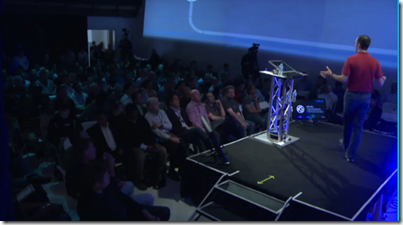A summary of the major announcements at the “Meet Windows Azure” conference
Despite its intimate, low-key nature, there were a pretty major collection of Windows Azure messages at this event with new major features being announced for the first time. It really must have been a struggle for the Redmond Azure team to have kept so quiet about so many announcements. Invitations, blog entries, communications, newsletters – they all gave no (or few [go back and look at the wording of some of them now, with hindsight]) clues to the enormity of the announcements.
Scott Guthrie kicked off with “We have a new portal”. So understated. It wasn’t so much the new portal as the range of new features that exist within it! The most important of which has got to be the new IaaS service (a preview). You can now provision a durable, persistent VM. The portal allows you to create VMs based on Server 2008 R2, Windows 8 Server, a pre-configured/installed SQL Server and a range of Linux VMs. Yes – you did just read that right. Microsoft has Linux VMs running in its data-centers… But he also mentioned you could even install Active Directory. You could pretty much replicate your entire enterprise environment in the Azure cloud.
Next piece of big news was the extensions to the virtual networking capability. The virtual network until now has relied on endpoint software being installed on to all instances of all roles that you want to be part of the network, and on to each computer in your on-premises environment. Well, now you can create VPNs using VPN devices from the big manufacturers like CISCO (as well as the old way of doing it).
Then they introduced Windows Azure Web Sites. You may have heard rumours in the past about the “lightweight web role” – that’s this thing. Bill did 3 demos of deploying an MVC app, a node.js app and a PHP app. It comes with a complete set of CMS from all the usual suspects that ypou can deploy, either directly on to your site as part of the deployment process, or you can import say a Wordpress template directly and work with that in Visual Studio, The instrumentation showed the performance, requests etc. of the site (just as it does for VMs) and gave you the option of scaling out (and up) if your website happened to become mega-popular. There were 3 scaling options. The first one simply increased the number of processes your site ran on in this multi-tennanted environment. THe next one moved the site in to VMs and you could scale by adding VMs. The third option allowed you to sclae the power of your VM up from say a 1.0GHz single core “extra small” instance, to an “extra large instance” with 8 cores and 14 GB RAM. No announcements on pricing yet, but I’d imagine the multi-tennanted environmnet would be the cheapest and then as you grow in to multiple VMs, it probably switches to VM pricing.
There were then a series of announcements around things like distributed cache, identity and service bus.
There was an interesting presentation from a partner called Twilio. They have what is basically a phone service for creating things like conferencing systems and so on.
The first part was about how the consumerisation of IT is at odds with the traditional Enterprise software sales model. Look at most Enterprise software sites and they put all sorts of barriers in the way of you actually becoming a customer. His premise was that the successful sites of the future will have 3 main things. A tour, pricing information and a try-it button (usually for free for a defined time period). This made the service on offer great for “Doers” – the people who gets things done. He then went on to describe how cloud services such as Azure also exhibit these features. Then followed a demo in which he used a combination of twilio and Windows Azure to create a conference call and eventually send a message to the (rather large number of) people who dialled in…
Next was a case study of the site pottermore.com; the Harry Potter fans’ site with a lot of social/interactive content to be delivered. It had to be moved to Windows Azure because with a million sign-ups to the Beta in 10 hours, they had a good idea it would need to scale. It took them 3 months to migrate the architecture and 160,000 lines of code, plus a single database to a large collection of Windows Azure instances (up to 1000) running web and worker roles and 500 SQL Azure databases.
I’ll have a lot more to say in the next few days about these significant new features of WIndows Azure – especially IaaS VMs, Websites and Virtual Networking.
